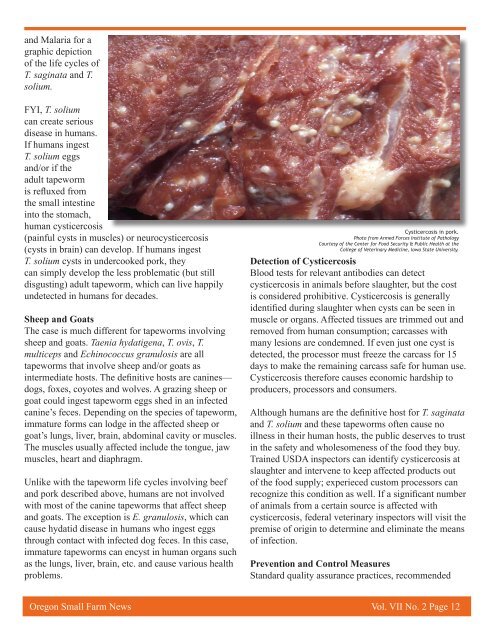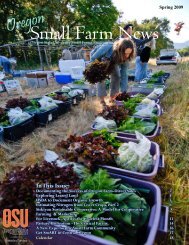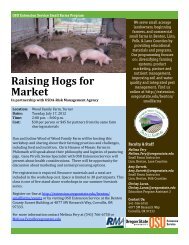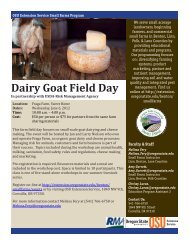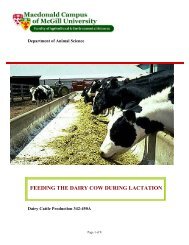Small Farm News - Oregon Small Farms - Oregon State University
Small Farm News - Oregon Small Farms - Oregon State University
Small Farm News - Oregon Small Farms - Oregon State University
You also want an ePaper? Increase the reach of your titles
YUMPU automatically turns print PDFs into web optimized ePapers that Google loves.
and Malaria for a<br />
graphic depiction<br />
of the life cycles of<br />
T. saginata and T.<br />
solium.<br />
FYI, T. solium<br />
can create serious<br />
disease in humans.<br />
If humans ingest<br />
T. solium eggs<br />
and/or if the<br />
adult tapeworm<br />
is refluxed from<br />
the small intestine<br />
into the stomach,<br />
human cysticercosis<br />
(painful cysts in muscles) or neurocysticercosis<br />
(cysts in brain) can develop. If humans ingest<br />
T. solium cysts in undercooked pork, they<br />
can simply develop the less problematic (but still<br />
disgusting) adult tapeworm, which can live happily<br />
undetected in humans for decades.<br />
Sheep and Goats<br />
The case is much different for tapeworms involving<br />
sheep and goats. Taenia hydatigena, T. ovis, T.<br />
multiceps and Echinococcus granulosis are all<br />
tapeworms that involve sheep and/or goats as<br />
intermediate hosts. The definitive hosts are canines—<br />
dogs, foxes, coyotes and wolves. A grazing sheep or<br />
goat could ingest tapeworm eggs shed in an infected<br />
canine’s feces. Depending on the species of tapeworm,<br />
immature forms can lodge in the affected sheep or<br />
goat’s lungs, liver, brain, abdominal cavity or muscles.<br />
The muscles usually affected include the tongue, jaw<br />
muscles, heart and diaphragm.<br />
Unlike with the tapeworm life cycles involving beef<br />
and pork described above, humans are not involved<br />
with most of the canine tapeworms that affect sheep<br />
and goats. The exception is E. granulosis, which can<br />
cause hydatid disease in humans who ingest eggs<br />
through contact with infected dog feces. In this case,<br />
immature tapeworms can encyst in human organs such<br />
as the lungs, liver, brain, etc. and cause various health<br />
problems.<br />
Cysticercosis in pork.<br />
Photo from Armed Forces Institute of Pathology<br />
Courtesy of the Center for Food Security & Public Health at the<br />
College of Veterinary Medicine, Iowa <strong>State</strong> <strong>University</strong>.<br />
Detection of Cysticercosis<br />
Blood tests for relevant antibodies can detect<br />
cysticercosis in animals before slaughter, but the cost<br />
is considered prohibitive. Cysticercosis is generally<br />
identified during slaughter when cysts can be seen in<br />
muscle or organs. Affected tissues are trimmed out and<br />
removed from human consumption; carcasses with<br />
many lesions are condemned. If even just one cyst is<br />
detected, the processor must freeze the carcass for 15<br />
days to make the remaining carcass safe for human use.<br />
Cysticercosis therefore causes economic hardship to<br />
producers, processors and consumers.<br />
Although humans are the definitive host for T. saginata<br />
and T. solium and these tapeworms often cause no<br />
illness in their human hosts, the public deserves to trust<br />
in the safety and wholesomeness of the food they buy.<br />
Trained USDA inspectors can identify cysticercosis at<br />
slaughter and intervene to keep affected products out<br />
of the food supply; experieced custom processors can<br />
recognize this condition as well. If a significant number<br />
of animals from a certain source is affected with<br />
cysticercosis, federal veterinary inspectors will visit the<br />
premise of origin to determine and eliminate the means<br />
of infection.<br />
Prevention and Control Measures<br />
Standard quality assurance practices, recommended<br />
<strong>Oregon</strong> <strong>Small</strong> <strong>Farm</strong> <strong>News</strong> Vol. VII No. 2 Page 12


